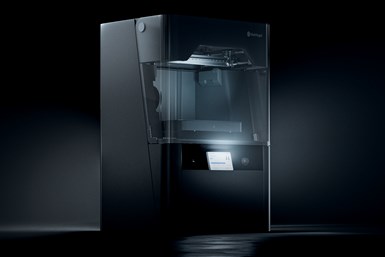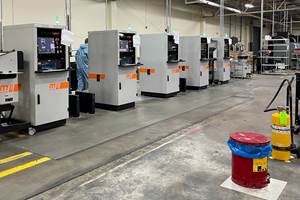Markforged’s FX10 Industrial 3D Printer Replaces Metal Parts With Advanced Composites
This fifth-generation print system features built-in automation for quality assurance and print routines designed to deliver strong, accurate parts every print.
Share
Read Next
The Markforged FX10 industrial 3D printer prints continuous carbon fiber-reinforced parts for a wide range of factory floor applications. Photo Credit: Markforged
Markforged’s FX10 industrial 3D printer is designed with flexibility in mind, with the printer’s modular systems engineered to be expanded and upgraded with additional capabilities. For example, the FX10 has been designed to incorporate a printhead integrated vision module to capture detailed part images and data to further ensure part quality and optimize printer performance.
The 5th Generation continuous fiber reinforcement (CFR) print system delivers high print quality in a heated print chamber that enables print speeds that are nearly twice as fast and print sizes that are up to twice as large as previous Markforged industrial series printers, enabling the replacement of metal parts with advanced composites.
The FX10 prints continuous carbon fiber-reinforced parts for a wide range of factory floor applications — helping manufacturers increase speed to market, slash fabrication and inventory costs, and de-risk line down events. The two printhead-mounted optical sensors automatically verify the dimensional accuracy of parts during the print to ensure consistency and reliability, while also assessing machine health and performance
The laser micrometer in the FX10 scans parts during printing and assists with the machine’s automatic calibration, while the new Vision Module captures detailed images of calibration parts to determine and optimize printer performance. Inspection software interprets the data from the sensors for dimensional verification, providing users with quality assurance as soon as a print finishes.
The material drawer of the FX10 contains built-in, individually sealed storage bays for up to four 800-cc spools. FX10 is able to automatically execute spool changeovers between filament storage bays during a print, and users can reload empty spool bays without disrupting a print.
The FX10 was designed to ensure easy adoption on the manufacturing floor starting with the first line operator. The system features a 7" touchscreen. A simple touchscreen interface combined with new automation and quality assurance technologies enable users to get more parts out of the FX10 with fewer interactions needed by the operator before and during a print than with previous Markforged printers. Users can start builds, monitor machine status, manually control the machine and start automated calibration routines all in one place.
The printer operates on the Digital Forge, which is Markforged’s additive platform that features intuitive device and desktop software, training and built-in cost calculation. Users can start generating ROI on day one and effortlessly scale to more teams, machines and facilities. A complete AM platform consisting of printers, cloud-enabled software with process improvement tools and a wide range of industrial materials, The Digital Forge is purpose-built to integrate into existing manufacturing ecosystems. With the Digital Forge, users can share parts across their organization and monitor fleet performance from a central location.
“We engineered the FX10 to be the best tool for the manufacturing floor,” says Shai Terem, Markforged CEO. “The FX10 allows manufacturers to slash original part replacement costs when compared to traditional methods and keep production lines running without worrying about supply chain issues or spare parts inventory. The FX10 can accelerate the digitization of the manufacturing floor by increasing the adoption of digital inventory to build supply chain resiliency. Our customers now have the potential to save even more capital by reducing physical inventory and boosting production yields, while decreasing operating costs.”
The FX10 printer is designed to supercharge manufacturing line productivity and profitability. The company says the printer empowers users to print the right part when and where it is needed, thereby reducing costs and cutting lead times from months to days, compared to traditional manufacturing methods.
“The FX10 is another important milestone in our mission to bring industrial production to the point of need. It enables our customers to address even more industrial applications with clear return on investment. Coupled with our Digital Source platform, we are truly starting to bring the vision of distributed manufacturing into reality,” Terem says. “The FX10 features a full suite of automation built to simplify the usage of the printer and increase adoption to build resiliency into our customers’ production. When a line is down or a tool is needed, FX10 users can simply press Print.”
- Check out the latest materials from Markforged as it reformulates H13, D2 tool steel for more flexible, less brittle filaments, which are reformulations of Markforged’s most popular tool steels.
- Read about Markforged’s Digital Source Platform which enables printing parts on-demand. The platform enables manufacturer-certified parts to be licensed and printed at the point of need.
Related Content
Additive Manufacturing Production at Scale Reveals the Technology's Next Challenges: AM Radio #28
Seemingly small issues in 3D printing are becoming larger problems that need solutions as manufacturers advance into ongoing production and higher quantities with AM. Stephanie Hendrixson and Peter Zelinski discuss 6 of these challenges on AM Radio.
Read MoreDMG MORI: Build Plate “Pucks” Cut Postprocessing Time by 80%
For spinal implants and other small 3D printed parts made through laser powder bed fusion, separate clampable units resting within the build plate provide for easy transfer to a CNC lathe.
Read MoreHow AM Enables Cobot Automation for Thyssenkrupp Bilstein (Includes Video)
The shock absorber maker has responded to its staffing shortages through extensive use of collaborative robots. In-house 3D printing makes this possible by providing the related hardware needed to complete the cobot-automated cells.
Read MoreUnderstanding HP's Metal Jet: Beyond Part Geometry, Now It's About Modularity, Automation and Scale
Since introducing its metal binder jetting platform at IMTS in 2018, HP has made significant strides to commercialize the technology as a serial production solution. We got an early preview of the just-announced Metal Jet S100.
Read MoreRead Next
4 Ways the Education and Training Challenge Is Different for Additive Manufacturing
The advance of additive manufacturing means we need more professionals educated in AM technology.
Read MoreAt General Atomics, Do Unmanned Aerial Systems Reveal the Future of Aircraft Manufacturing?
The maker of the Predator and SkyGuardian remote aircraft can implement additive manufacturing more rapidly and widely than the makers of other types of planes. The role of 3D printing in current and future UAS components hints at how far AM can go to save cost and time in aircraft production and design.
Read More3D Printing Brings Sustainability, Accessibility to Glass Manufacturing
Australian startup Maple Glass Printing has developed a process for extruding glass into artwork, lab implements and architectural elements. Along the way, the company has also found more efficient ways of recycling this material.
Read More























